Writing an essay can feel like a lot. You sit down, the cursor blinks at you, and suddenly, every idea you had disappears into thin air. But once you break it into steps, it gets way less intimidating. Some students think that in order to write a quality essay, you have to be a ‘natural writer’, but really, you just need to know where to begin and how to keep it going.
Here’s how most essays come together:
- Start by figuring out what the essay question is really asking
- Jot down your thoughts and dig into some background reading
- Pick a direction and write a thesis you can actually support
- Map out your main points before diving into full paragraphs
This article will walk you through what writing an essay actually looks like. We’ll give you tips and strategies to take your writing to the next level.
But knowing how to write an essay is one thing. Getting it done is another. If your draft’s a mess or the words just won’t come, EssayPro is here for you. Pay for essay and rest assured while we take care of the writing.
Main Stages of Writing an Essay
Until you break it down into small parts, writing a full essay can seem like a huge task. Most students think you have to sit down and write it all at once, but the truth is, strong writing happens in stages. Here’s a little essay writing guide:
- Understand the assignment: Figure out what the essay question is actually asking.
- Research and brainstorm: Gather sources, jot down ideas, and see what stands out.
- Outline your thoughts: Decide your main idea and organize your essay structure before jumping in.
- Write your draft: Start with your intro, follow through with the body, and end with a strong conclusion.
- Edit and refine: Read it out loud, fix awkward parts, and make sure it all connects.
Getting Ready for Writing an Essay
A little time spent here saves a ton later. Before you type your first word, stop and get your bearings. Rushing into an essay without a plan usually means backtracking later. Good writing starts with even better prep.
- First, read the essay question slowly and highlight the key terms to understand what the prompt actually wants. Are you supposed to argue, explain, reflect, or compare?
- Now take a minute to think. What’s your first reaction to the topic? Write it down. Think of examples, personal opinions, facts you already know. This is your raw material.
- Once your ideas are on paper, begin researching. Don’t just Google and copy. Look for sources that add something useful. Take notes and group ideas together to help yourself spot early patterns.
- Now outline. Nothing fancy. Just list your main points in the order in which you want to write them. Think of this as your essay’s skeleton. It doesn’t move, yet it gives your writing shape.
And once you're ready for the final review, make sure to go through this checklist!


Write the Introduction
The intro is where your reader decides if they’re going to keep going. That first paragraph does a lot of heavy lifting. It grabs attention, sets the tone, and hints at where you’re heading. If you get it right, the rest of the essay becomes much easier to follow and easier to write, too.

For help with assignments that go beyond essays, like coursework, our coursework writer service is available too.
Catch the Reader’s Attention
The first step of writing an essay is to come up with a hook that makes someone pause. It should land like a small jolt, not a warm-up sentence. Think bold, surprising, or slightly uncomfortable. A good essay hook sets the tone and grabs the reader’s attention right away. The whole point of a hook is to hint at what’s to come later in the essay. Come up with a hook catchy enough to push the reader to keep reading.
Example: 'You won’t find it on the tag, but every fast fashion item comes with a second price, one the buyer never pays.'
This line shifts focus. Suddenly, fashion isn’t about trends. It’s about cost, and not the one on the receipt. That’s what makes someone keep reading.
Set the Scene with Background Info
Once you’ve drawn them in, don’t rush into your argument. Give just enough context to help the reader follow your point. If fast fashion is your topic, set it up like you would in a conversation: no info dump, just the basics that matter right now.
Example: 'Over the last decade, stores have trained us to expect cheap clothes, constant new arrivals, and sales that feel too good to skip. It’s easy to buy more than we need when the cost feels low, but someone, somewhere, is paying for that convenience.'
This builds a bridge from what readers already know about shopping to what they may not have considered, which is the real cost behind it.
Say What You’re Arguing
This is where you make your point. Don’t hedge. Say it like you mean it. The thesis is your position, and the rest of your essay will either prove it, build on it, or dig deeper into it.
Example: 'Though fast fashion may seem harmless, its rapid production model fuels deep harm, from sweatshops to climate change.'
Now the reader knows where you stand. Instead of just writing about trends or price points, you’re showing the damage that hides behind the bargain rack.
Give a Quick Roadmap
Your reader shouldn’t feel lost after the intro. A roadmap helps them understand what to expect, and it keeps your writing on track, too.
Example: 'This essay will examine how the industry operates, what it costs the world beyond the storefront, and how everyday choices can lead to something better.'
You’re saying: I’m taking you somewhere, and it’s worth it.
For more details, read our article on How to Write an Introduction.
Write the Main Body
You’ve introduced the topic, and now it’s time to explore it. The main body is where you lay things out clearly, one idea at a time, and back them up with evidence. Each paragraph should serve one purpose and move your reader forward. Structure your points, build them with support, explain why they matter, and guide the reader from one idea to the next.

How Much Should You Write?
There’s no single rule for how long your body should be, but it will always take up most of your essay. A short piece might have just two body paragraphs. A longer one could have five or more. What matters most is that each one focuses on a single idea and develops it fully before moving to the next.
Optimal Paragraph Structure
Each body paragraph is like a mini-essay. It has a beginning, a middle, and a conclusion. Introduce the topic, follow that with supporting details (facts, quotes, or examples) that give it weight. Then add your own analysis to explain how that evidence connects to your argument. Finally, ease the reader into the next paragraph with a smooth transition. That rhythm helps your writing feel steady and easy to follow.
Start Strong with the Topic Sentence
The topic sentence is a line that tells the reader exactly what that section is about. That sets up the paragraph’s focus and gives you space to dig into the how and why behind it. It doesn’t need to be fancy, just clear and direct.
Example: 'Fast fashion thrives because it creates the illusion of value through low prices and constant new arrivals.'
Back It Up with Evidence
Now you need to back up your topic sentence with a statistic, a quote from a source, or a short example that illustrates your point. That kind of detail gives it real-world weight. Use relevant and reliable sources, and always make sure your evidence connects to the claim you’re making.
Example: 'According to the Ellen MacArthur Foundation, the average person now buys 60% more clothing than they did 15 years ago, but keeps each item half as long.'
Looking for solid, cited sources? Try our research paper services to support your writing with reliable information.
Analyze and Say Why It Matters
Now that you’ve presented your evidence, don’t just move on. Take a moment to explain why it matters. Your analysis is where your voice comes through, where you connect the dots and show the reader how the evidence supports your main idea. Without this part, your paragraph feels unfinished.
Example: ‘This pattern shows how fast fashion trains consumers to see clothing as disposable, encouraging more purchases while hiding the true cost behind the low price tag.’
Help the Reader Keep Going
End your paragraph by pointing to what’s next. A good transition sentence wraps up your current point and hints at the one coming up. This is a lot like a bucket brigade, but instead of people passing items, there are paragraphs connecting to each other with transition sentences. It helps your reader move smoothly through your essay instead of feeling like they’re jumping between random ideas.
Example: ‘While price plays a big role, the real driver behind fast fashion is speed, and that’s where the next problem begins.’
If you’re looking for help organizing your ideas, try this 5 paragraph essay outline.
Write the Conclusion
A strong essay conclusion leaves your reader with something to hold on to. It’s your final chance to pull everything together and walk off with purpose. Here’s How to Write a Conclusion:
- Revisit your thesis without sounding robotic
- Recap the main points, but don’t just list them
- Leave the reader with something to think about
- End with a sentence that feels like a full stop

Remind the Reader What You Argued
Your thesis deserves one last moment in the spotlight, but it shouldn’t feel like a copy-paste. Rephrase it in a way that reflects everything you’ve covered.
Example:
Original: 'Fast fashion causes harm to both people and the planet.'
Restated: 'In the end, the real cost of fast fashion is measured not in dollars, but in lives and environmental damage.'
Pull the Main Ideas Back Together
Now’s your chance to quickly remind readers of the key things they’ve just read. Instead of just listing your body paragraphs, connect the dots and create a full picture.
Example: ‘By looking at fast fashion’s rapid rise, the harm it causes behind the scenes, and the role we play as consumers, it’s clear that change doesn’t just start in factories. It starts in closets.’
Leave Them With a Thought
What’s the bigger picture? What do you want the reader to carry with them after they’re done reading? This is where you can go a little deeper.
Example: ‘We often treat clothing as temporary, but the effects of what we buy last much longer. Thinking twice before shopping could be the most unexpected form of activism we have.’
Give It a Proper Ending
You don’t want your essay to just stop. A strong last sentence gives your reader the feeling that everything has come full circle.
Example: ‘If fashion is about expression, maybe the most powerful statement we can make is choosing what and who we’re really supporting.’
Need to finish fast? Try our tips on how to write an essay fast.
What to Avoid in a Conclusion
Even a great essay can stumble at the finish line. Here’s what not to do in your conclusion:
- Don’t introduce brand-new arguments or ideas
- Don’t start with 'In conclusion' or 'To summarize'
- Don’t undermine your own argument with phrases like 'I might be wrong but…'
- Don’t make your conclusion longer than your body paragraph
- Don’t repeat your thesis word-for-word
To make sure everything’s in place, feel free to use this essay format guide.
Before You Go
If you’re still staring at a blank doc or wondering if your paragraphs even make sense, you’re not alone. Here’s what to remember:
- Start with the question, not just your opinion
- A strong thesis makes everything else easier to write
- One idea per paragraph keeps your writing focused
- Real evidence plus real explanation = a strong point
- Your voice matters, and it doesn’t have to sound like a textbook
And if things still feel stuck, EssayPro can help. Buy an essay online from one of your expert writers. Our support is just one click away.
Pressed for Time but Still Need to Submit?
Let our experts craft an original, high-quality essay while you focus on other tasks.
FAQs
What Is an Essay?
An essay is your take on a topic, built around a main idea (your thesis) and supported with explanation, examples, and evidence.
How Do I Start Writing an Essay?
Start by figuring out what the question is really asking. Once you’ve got that, jot down a few ideas, do some background reading, and pick a direction you can stick with. Then, build your intro around that.
What Are the 5 Steps of Writing an Essay?
- Understand the topic or question
- Brainstorm and research
- Write your thesis and outline your points
- Draft your body paragraphs
- Wrap it up with a conclusion and revision

Daniel Parker
is a seasoned educational writer focusing on scholarship guidance, research papers, and various forms of academic essays including reflective and narrative essays. His expertise also extends to detailed case studies. A scholar with a background in English Literature and Education, Daniel’s work on EssayPro blog aims to support students in achieving academic excellence and securing scholarships. His hobbies include reading classic literature and participating in academic forums.
- Harvard College Writing Center. (n.d.). Strategies for essay writing. Harvard University. https://writingcenter.fas.harvard.edu/pages/strategies-essay-writing
- University of Melbourne. (n.d.). Writing a great essay. Academic Skills, Students. https://students.unimelb.edu.au/academic-skills/resources/reading,-writing-and-referencing/essays/writing-a-great-essay







